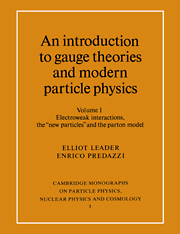Book contents
- Frontmatter
- Contents
- Preface
- Acknowledgements
- Notational conventions
- Note added in proof: the discovery of the top quark (?)
- Note added in proof: the demise of the SSC
- 1 Field theory and pre-gauge theory of weak interactions
- 2 The need for a gauge theory
- 3 Spontaneous symmetry breaking: the Goldstone theorem and the Higgs phenomenon
- 4 Construction of the standard model
- 5 Lowest order tests of the SM in the leptonic sector
- 6 The Higgs boson
- 7 The standard model beyond lowest order
- 8 e+e− physics and the standard model
- 9 Extension to the hadrons; quark–lepton universality
- 10 Phenomenology of semi-leptonic reactions
- 11 The discovery of the narrow vector resonances
- 12 Hidden flavour bound states
- 13 Open heavy flavours
- 14 The heavy lepton τ
- 15 Towards the parton model—deep inelastic scattering
- 16 The quark–parton model
- 17 Experimental tests of the quark-parton model
- Appendix 1 Elements of field theory
- Appendix 2 Feynman rules for QED, QCD and the SM
- Appendix 3 Conserved vector currents and their charges
- References
- Analytic subject index for vols. 1 and 2
Preface
Published online by Cambridge University Press: 19 March 2010
- Frontmatter
- Contents
- Preface
- Acknowledgements
- Notational conventions
- Note added in proof: the discovery of the top quark (?)
- Note added in proof: the demise of the SSC
- 1 Field theory and pre-gauge theory of weak interactions
- 2 The need for a gauge theory
- 3 Spontaneous symmetry breaking: the Goldstone theorem and the Higgs phenomenon
- 4 Construction of the standard model
- 5 Lowest order tests of the SM in the leptonic sector
- 6 The Higgs boson
- 7 The standard model beyond lowest order
- 8 e+e− physics and the standard model
- 9 Extension to the hadrons; quark–lepton universality
- 10 Phenomenology of semi-leptonic reactions
- 11 The discovery of the narrow vector resonances
- 12 Hidden flavour bound states
- 13 Open heavy flavours
- 14 The heavy lepton τ
- 15 Towards the parton model—deep inelastic scattering
- 16 The quark–parton model
- 17 Experimental tests of the quark-parton model
- Appendix 1 Elements of field theory
- Appendix 2 Feynman rules for QED, QCD and the SM
- Appendix 3 Conserved vector currents and their charges
- References
- Analytic subject index for vols. 1 and 2
Summary
For a book of its genre, our previous book, An introduction to gauge theories and the “new physics” (1982) was a great success. It was not, alas, sold in airport lounges, but it did run to two additional printings (1983, 1985), and to extensively revised editions in Russian (1990), and in Polish (1991). More importantly, it seemed to achieve the principal goal which we had set ourselves, namely, to present a pedagogical account of modern particle physics with a balance of theory and experiment, which would be intelligible and stimulating for both theoretical and experimental graduate students. We did not try to write a profound book on field theory, nor a treatise on sophisticated experimental techniques. But we did wish to stress the deep, intimate and fruitful interaction between theoretical ideas and experimental results. Indeed, for us, it is just this aspect of physics which makes it seem so much more exciting than say pure mathematics. Our greatest pleasure came from the favourable reaction of students who were working through the book and from those reviewers who caught what we hoped was its essential flavour—‘the writing creates the feeling of an active progression of ideas arising from the repeated interaction of theoretical prejudice with experimental observation’, ‘unlike most textbooks, it is highly readable, and makes everything appear simple and obvious’. Well, the last comment is surely an exaggeration but that was our aim.
In thinking about a second edition we were faced with a serious conceptual problem. Ten years ago we were in a state of excited expectation.
- Type
- Chapter
- Information
- An Introduction to Gauge Theories and Modern Particle Physics , pp. xxi - xxivPublisher: Cambridge University PressPrint publication year: 1996

